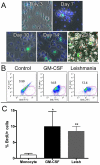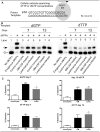Leishmania induces survival, proliferation and elevated cellular dNTP levels in human monocytes promoting acceleration of HIV co-infection
- PMID: 22496656
- PMCID: PMC3320607
- DOI: 10.1371/journal.ppat.1002635
Leishmania induces survival, proliferation and elevated cellular dNTP levels in human monocytes promoting acceleration of HIV co-infection
Abstract
Leishmaniasis is a parasitic disease that is widely prevalent in many tropical and sub-tropical regions of the world. Infection with Leishmania has been recognized to induce a striking acceleration of Human Immunodeficiency Virus Type 1 (HIV-1) infection in coinfected individuals through as yet incompletely understood mechanisms. Cells of the monocyte/macrophage lineage are the predominant cell types coinfected by both pathogens. Monocytes and macrophages contain extremely low levels of deoxynucleoside triphosphates (dNTPs) due to their lack of cell cycling and S phase, where dNTP biosynthesis is specifically activated. Lentiviruses, such as HIV-1, are unique among retroviruses in their ability to replicate in these non-dividing cells due, at least in part, to their highly efficient reverse transcriptase (RT). Nonetheless, viral replication progresses more efficiently in the setting of higher intracellular dNTP concentrations related to enhanced enzyme kinetics of the viral RT. In the present study, in vitro infection of CD14+ peripheral blood-derived human monocytes with Leishmania major was found to induce differentiation, marked elevation of cellular p53R2 ribonucleotide reductase subunit and R2 subunit expression. The R2 subunit is restricted to the S phase of the cell cycle. Our dNTP assay demonstrated significant elevation of intracellular monocyte-derived macrophages (MDMs) dNTP concentrations in Leishmania-infected cell populations as compared to control cells. Infection of Leishmania-maturated MDMs with a pseudotyped GFP expressing HIV-1 resulted in increased numbers of GFP+ cells in the Leishmania-maturated MDMs as compared to control cells. Interestingly, a sub-population of Leishmania-maturated MDMs was found to have re-entered the cell cycle, as demonstrated by BrdU labeling. In conclusion, Leishmania infection of primary human monocytes promotes the induction of an S phase environment and elevated dNTP levels with notable elevation of HIV-1 expression in the setting of coinfection.
Conflict of interest statement
The authors have declared that no competing interests exist.
Figures






Similar articles
-
Macrophage tropism of HIV-1 depends on efficient cellular dNTP utilization by reverse transcriptase.J Biol Chem. 2004 Dec 3;279(49):51545-53. doi: 10.1074/jbc.M408573200. Epub 2004 Sep 26. J Biol Chem. 2004. PMID: 15452123 Free PMC article.
-
Vpx requires active cellular dNTP biosynthesis to effectively counteract the anti-lentivirus activity of SAMHD1 in macrophages.J Biol Chem. 2023 Aug;299(8):104984. doi: 10.1016/j.jbc.2023.104984. Epub 2023 Jun 28. J Biol Chem. 2023. PMID: 37390988 Free PMC article.
-
p21-mediated RNR2 repression restricts HIV-1 replication in macrophages by inhibiting dNTP biosynthesis pathway.Proc Natl Acad Sci U S A. 2013 Oct 15;110(42):E3997-4006. doi: 10.1073/pnas.1306719110. Epub 2013 Sep 30. Proc Natl Acad Sci U S A. 2013. PMID: 24082141 Free PMC article. Clinical Trial.
-
Unveiling the Connection: Viral Infections and Genes in dNTP Metabolism.Viruses. 2024 Sep 3;16(9):1412. doi: 10.3390/v16091412. Viruses. 2024. PMID: 39339888 Free PMC article. Review.
-
Hydroxyurea: mechanisms of HIV-1 inhibition.Antivir Ther. 1998;3 Suppl 4:25-33. Antivir Ther. 1998. PMID: 10723506 Review.
Cited by
-
Case Report: Severe Visceral Leishmaniasis in a Patient with HIV Coinfection Undergoing Treatment for Erythema Nodosum Leprosum.Am J Trop Med Hyg. 2020 Dec;103(6):2253-2256. doi: 10.4269/ajtmh.20-0567. Epub 2020 Sep 3. Am J Trop Med Hyg. 2020. PMID: 32901606 Free PMC article.
-
The immunological, environmental, and phylogenetic perpetrators of metastatic leishmaniasis.Trends Parasitol. 2014 Aug;30(8):412-22. doi: 10.1016/j.pt.2014.05.006. Epub 2014 Jun 20. Trends Parasitol. 2014. PMID: 24954794 Free PMC article. Review.
-
Impact of Leishmania infection on host macrophage nuclear physiology and nucleopore complex integrity.PLoS Pathog. 2015 Mar 31;11(3):e1004776. doi: 10.1371/journal.ppat.1004776. eCollection 2015 Mar. PLoS Pathog. 2015. PMID: 25826301 Free PMC article.
-
DNA prime-protein boost vaccine encoding HLA-A2, HLA-A24 and HLA-DR1 restricted epitopes of CaNA2 against visceral leishmaniasis.Immunology. 2019 Jan;156(1):94-108. doi: 10.1111/imm.13007. Epub 2018 Oct 24. Immunology. 2019. PMID: 30285279 Free PMC article.
-
DNA methylation alterations caused by Leishmania infection may generate a microenvironment prone to tumour development.Front Cell Infect Microbiol. 2022 Aug 29;12:984134. doi: 10.3389/fcimb.2022.984134. eCollection 2022. Front Cell Infect Microbiol. 2022. PMID: 36105147 Free PMC article. Review.
References
-
- Alvar J, Yactayo S, Bern C. Leishmaniasis and poverty. Trends Parasitol. 2006;22:552–557. - PubMed
Publication types
MeSH terms
Substances
Grants and funding
LinkOut - more resources
Full Text Sources
Other Literature Sources
Medical
Research Materials

